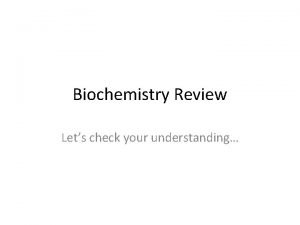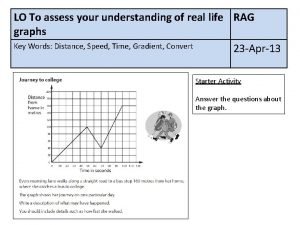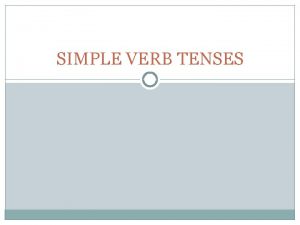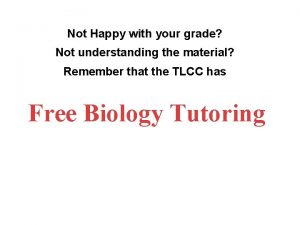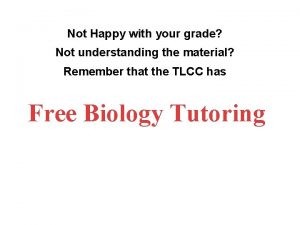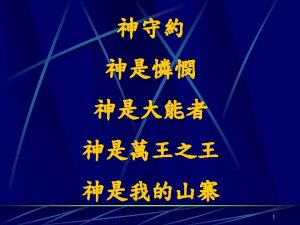Not Happy with your grade Not understanding the


























































- Slides: 58

Not Happy with your grade? Not understanding the material? Remember that the TLCC has Free Biology Tutoring

Discover Biology FIFTH EDITION CHAPTER 12 Genetics © 2012 W. W. Norton & Company, Inc.

Gregor Mendel: “Father of Genetics” • 1866: a paper on peas • ignored for 30 years • Everything rediscovered Hugo de Vries Carl Correns

Gregor Mendel: He Studied Peas • Bred peas, tracked 7 traits • Looked for mathematical patterns in offspring • Before Mendel: “kids are blend of parents traits” For most traits: FALSE

Mendel: Inherited Traits Kids get two sets of info one from each parent Most traits don’t blend No idea what information was or how it was stored

After Mendel: “genetics” • Watson & Crick: structure of DNA Info stored in DNA • Now: epigenetics – info on what DNA to read

Vocabulary for in Genetics • Gene: an instruction written in DNA Usually instructions for a protein many genes on each chromosome • Genotype: The type of Genes you have • Phenotype: The traits you display hair color, freckles, blood type, eyesight (many are things you can feel)

Vocabulary for in Genetics • genetic trait: anything you can see/detect Invariant – everybody the same variable – in your phenotype “Express” a gene – have, and show not just in genotype also in phenotype

Diploid Cells: 2 Copies of all Genes Normal (somatic) cells: diploid (2 n) 2 copies of each chromosome “homologous pair” homologous pair: 1 paternal, 1 maternal homologue Humans: 23 pairs, 46 total

Haploid Cells: Half the normal DNA Somatic (normal) cells: diploid (2 n) reproductive (Gamete) cells: One set of chromosomes some from each parent Haploid (1 n) Meiosis, not mitosis


Vocabulary for in Genetics • Alleles: versions of a gene hair color gene blonde allele redhead allele brunette allele black hair allele Genetic Diversity: having more than one version (allele) of a gene in a population More alleles = more genetic diversity

Genotype terms • Phenotype: the genes you express • Genotype: the genes you have Homozygous: all the same alleles (versions) of a gene “Homo” = same kind Heterozygous: more than one allele (version) of a gene “Hetero” = not the same kind

Genotype terms • Hybrid: has heterozygous genotype (Ss) • Dihybrid: is heterozygous for two traits (Ss. Tt)

Genotype terms • Dominant: an allele (version) that will be expressed if it is there • Recessive: an allele that will be expressed if it is not being blocked • Multigenic: a trait controlled by more than one gene

Genotype Symbols Use same letter for same gene Capital Letter: use for dominant allele (version) Lower Case Letter: use for recessive allele

Mutations: making new alleles • Mutation: changes to DNA new version (allele) of gene = genetic diversity • Bad mutations: often recessive – You survive if you have a good copy (dominant) – Pass harmful version on to kids

Mutations: making new alleles • mutations are random • Only passed on if in cells making gametes • often no effect • Sometimes good (rare)

Controlled Crosses: what Mendel did • genetic cross: controlled mating experiment used to learn about inheritance • P generation: parents (P) • Filial (F): descendants F 1 generation = kids F 2 generation = grandkids


Mendel: He liked peas • true-breeding: purebred (homogenous) • Mendel crossed purebreeding plants • Recorded phenotype of offspring .

Mendel’s Results • Mendel repeatedly observed a 3: 1 ratio of dominant to recessive phenotypes

Modern interpretation of Mendel’s Five important ideas 1. Variation in traits = different versions of genes 2. one copy of a gene from each parent 3. Dominant = expressed if present (controls phenotype) 4. Two copies of a gene separate in meiosis end up in separate gametes 5. Gametes fuse randomly


Mendel REALLY liked peas . • LOTS of experiments: 7 years, 29 K plants • Experiments tracking one trait described before – e. g. flower color Mendel found law of segregation: the two copies of a gene are separated during meiosis and end up in different gametes

Law of Segregation • Punnett square: shows all the possible ways in which two alleles can recombine through fertilization

Magic Ratio: 3: 1 in F 2

Magic Ratio: 9: 3: 3: 1 in F 2

Mendel: more peas, please Experiments tracking two traits e. g. seed color and texture dihybrid cross: parents are heterozygous for two traits Mendel found independent assortment • 2 copies of a gene segregate separately from the 2 copies of other genes Only works on if genes are on different chromosomes .


Probability • can predict the probability of a phenotype or genotype • Can’t predict actual phenotype or genotype • probability of a specific phenotype unaffected by # of offspring Siblings don’t count!!

Mendel Got Lucky • All the traits he looked at were easy controlled by one gene normal dominant and recessive alleles lots of traits are more messy • His laws were “expanded” to explain more complicated stuff

Incomplete Dominance • Dominant: an allele (version) that will be expressed if it is there • Recessive: an allele that will be expressed if it is not being blocked • Incomplete dominance: dominant genes doesn’t fully block recessive

Incomplete Dominance • Incomplete dominance: dominant genes doesn’t fully block recessive Dominant is expressed (sort of) Recessive is expressed (sort of) intermediate phenotype pink, not red or white • Magic ratio: 1: 2: 1 in F 2


Codominant Codominance - more than one dominant (Can still have a recessive allele) have both traits (equally visible) No blending or diluting AB blood type have type A proteins on RBC have type B proteins on RBC


Magic Ratios Reveiw – 3: 1 in F 2 • This gene has complete (normal) dominance • The more common trait is dominant • The less common trait is recessive • the parents were both heterozygotes

Magic Ratios Reveiw – 1: 2: 1 in F 2 • This gene has incomplete dominance • The most common trait is heterozygous

Magic Ratios Review – 9: 3: 3: 1 in F 2 • Two traits, both 3: 1 • Both traits are normal dominance • Genes move independently of each other

Pleiotropic Genes Gene that controls more than one trait mutation in one gene changes many things Albinism skin or hair pigment light sensitivity in eyes


Multigenic traits Multigenic: more than one gene needed “epistasis” = Gene A depends on Gene B independently inherited genes both needed for phenotype Animal fur color: tyrosine melanin multistep pathway (several enzymes) several genes

Mice: B gene depends on C gene

Genes affected by environment External factors can alter gene expression Chemicals nutrition sunlight temperature

Hydrangea: Soil p. H and trace elements

Genes and Temperature melanin in Siamese cats: Same fur gene on whole body Cool areas of body have dark fur

Himalayan rabbits

Himalayan rabbits

Temperature: Alligator sex

Multigenic/Polygenic • MOST traits depend on more than one gene Humans - Skin color, running speed, blood pressure, body size • Geneticists: “more than a dozen genes that control melanin” environmental factors: even more variation MENDEL GOT LUCKY!!! (Chose simple stuff to study)


Complex Traits • Many factors: predicting phenotype is difficult

Clicker Questions CHAPTER 12 Patterns of Inheritance

Concept Quiz A red carnation and a white carnation produce offspring that are all pink. The type of inheritance pattern occurring is: A. Complete dominance B. Incomplete dominance C. Codominance

Concept Quiz If an allele for tall plants (T) is dominant to short plants (t), what offspring would you expect from a TT x Tt cross? A. ½ tall; ½ short B. ¾ tall; ¼ short C. All tall

Concept Quiz Fur color in rabbits shows incomplete dominance. FBFB individuals are brown, FBFW individuals are cream, FWFW individuals are white. What is the expected ratio of a FBFW x FWFW cross? A. 3 white : 1 brown B. 3 white : 1 cream C. 2 white : 2 cream

Not Happy with your grade? Not understanding the material? Remember that the TLCC has Free Biology Tutoring
 When she is happy i am happy
When she is happy i am happy Trust in the lord lean not on your own understanding song
Trust in the lord lean not on your own understanding song Lean not on your own understanding
Lean not on your own understanding Angry i guess
Angry i guess Happy sad hungry
Happy sad hungry Happy sad hungry thirsty hot cold
Happy sad hungry thirsty hot cold Happy feet happy life
Happy feet happy life Give us your hungry your tired your poor
Give us your hungry your tired your poor Name written in heaven
Name written in heaven Hapoy nod
Hapoy nod Understanding your stakeholders
Understanding your stakeholders Understanding your health and wellness chapter 1
Understanding your health and wellness chapter 1 Goodheart willcox chapter 1 answers
Goodheart willcox chapter 1 answers Chapter 1 understanding your health and wellness
Chapter 1 understanding your health and wellness Chapter 1 understanding health and wellness
Chapter 1 understanding health and wellness Let's check your understanding
Let's check your understanding Understanding your business finances
Understanding your business finances Understanding your digital footprint
Understanding your digital footprint Glencoe health chapter 1 understanding health and wellness
Glencoe health chapter 1 understanding health and wellness Fedcb
Fedcb Understanding your intuition
Understanding your intuition Distance time graph activity
Distance time graph activity Not genuine not true not valid
Not genuine not true not valid Not so happy yet much happier literary device
Not so happy yet much happier literary device Importance of constitution of india
Importance of constitution of india Be happy not because everything is good
Be happy not because everything is good Simple present form of verbs
Simple present form of verbs And the tree was happy
And the tree was happy Show not tell phrases for fear
Show not tell phrases for fear Hình ảnh bộ gõ cơ thể búng tay
Hình ảnh bộ gõ cơ thể búng tay Frameset trong html5
Frameset trong html5 Bổ thể
Bổ thể Tỉ lệ cơ thể trẻ em
Tỉ lệ cơ thể trẻ em Chó sói
Chó sói Tư thế worms-breton
Tư thế worms-breton Hát lên người ơi
Hát lên người ơi Các môn thể thao bắt đầu bằng tiếng chạy
Các môn thể thao bắt đầu bằng tiếng chạy Thế nào là hệ số cao nhất
Thế nào là hệ số cao nhất Các châu lục và đại dương trên thế giới
Các châu lục và đại dương trên thế giới Công thức tiính động năng
Công thức tiính động năng Trời xanh đây là của chúng ta thể thơ
Trời xanh đây là của chúng ta thể thơ Cách giải mật thư tọa độ
Cách giải mật thư tọa độ Làm thế nào để 102-1=99
Làm thế nào để 102-1=99 độ dài liên kết
độ dài liên kết Các châu lục và đại dương trên thế giới
Các châu lục và đại dương trên thế giới Thể thơ truyền thống
Thể thơ truyền thống Quá trình desamine hóa có thể tạo ra
Quá trình desamine hóa có thể tạo ra Một số thể thơ truyền thống
Một số thể thơ truyền thống Cái miệng nó xinh thế
Cái miệng nó xinh thế Vẽ hình chiếu vuông góc của vật thể sau
Vẽ hình chiếu vuông góc của vật thể sau Biện pháp chống mỏi cơ
Biện pháp chống mỏi cơ đặc điểm cơ thể của người tối cổ
đặc điểm cơ thể của người tối cổ Ví dụ về giọng cùng tên
Ví dụ về giọng cùng tên Vẽ hình chiếu đứng bằng cạnh của vật thể
Vẽ hình chiếu đứng bằng cạnh của vật thể Tia chieu sa te
Tia chieu sa te Thẻ vin
Thẻ vin đại từ thay thế
đại từ thay thế điện thế nghỉ
điện thế nghỉ Tư thế ngồi viết
Tư thế ngồi viết















